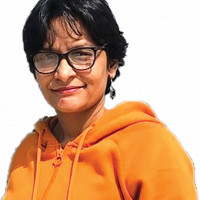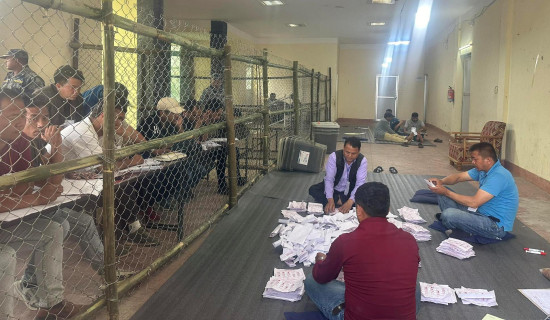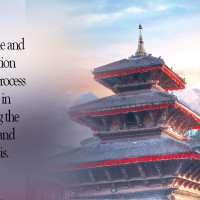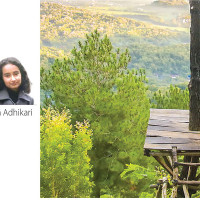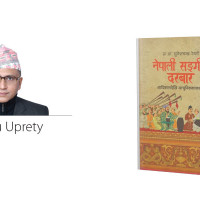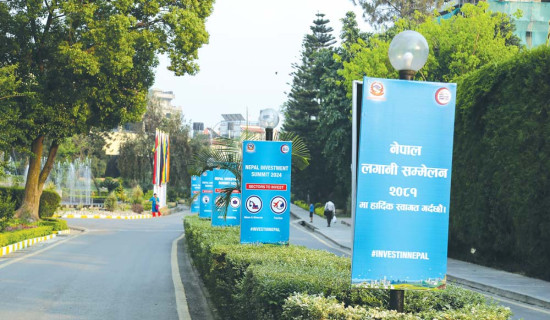- Tuesday, 30 April 2024
A Visit To Enchanting Kalinchowk
Nestled on the top of a rocky mountain in Dolakha district lies the Kalinchowk Bhagawati Temple, a popular religious and cultural destination that enchants the every traveller who reaches there.
Located at an elevation of 3,842 meters, the temple stands tall as a beacon of peace and spirituality, drawing visitors from far and wide.
Kalinchowk Bhagwati is a famous Hindu shrine located at Charikot of Kalinchowk Rural Municipality, under the Gaurishankar Conservation Area. The temple overlooks the Sunkoshi and Tamakoshi Rivers in the north, which originate from the Mahabharat Range.
Kalinchowk Temple lies about 150 kilometres north-east of the capital city Kathmandu and easily accessible via road transport. It is four to five hours' drive through the Araniko Highway until the road branches out east from Khandichaur.
From Charikot Bazaar of the district, one has to cover 17 kilometres of off-road portion. Anyone can hike for about two hours from Deurali and Gaire to reach the village of Kuri located on the foothill of Kalinchowk. To reach the hilltop temple where the Kalinchowk Bhagwati resides, it will take about 30 minutes to one hour hike up from Kuri Village. Or if you choose to go up by cable car, it will take just seven minutes.
Various festive occasions, especially Navaratri during the Dashain, witness a surge in pilgrims visiting Kalinchowk to pay homage and offer prayers to the power goddess. Besides its religious significance, Kalinchowk also attracts visitors with its scenic beauty, offering panoramic views of the Himalayan range to the north and opportunities for trekking and adventure activities.
The journey to the temple passes through scenic landscapes, lush forests, and enchanting mountain views, making it an appealing destination for nature lovers and adventure enthusiasts as well.
In the beautiful village of Kuri below the Kalinchowk temple, heavy snowfall is common, often reaching depths of three to five feet even during Spring season. To cope with anowfall, the roofs of houses in this village are typically built with slanted roofs so that the snow can easily slide off. The Kuri Valley is often called Nepal’s Switzerland for its wonderfully beauty and structure of houses resembling with the Western design.
Mythical tales
Kalinchowk is more than just a beautiful place. It is like a book filled with stories from long ago. According to myths, the Pandavas, once came here to meditate to find peace. They believed that a powerful goddess named Kali lived on the highest point of the mountain, adding to the magic of the land, says BK Pradhan, a social worker and Chairman of Dolakha Tourism Development Committee.

Kalinchowk is named after the goddess Kali who is prayed for power and destruction. It is believed that Goddess Kali used to meditate on the hilltop of Kalinchowk, known as Sumeru Parbat. During her meditation, evil forces tried to defeat her. This led to a fierce battle between Goddess Kali and the evil forces.
Lord Shiva intervened by using his divine Trishul (a metal trodent) and the holy water that originated from the dry land. This empowered Goddess Kali, and with her mighty lion on which she rode, she defeated the evils. Their bodies were decayed in a place called Kuri, giving the village its name, Pradhan said.
The water pond lying on the top of Kalinchowk is considered holy and pure. People believe that by taking water from this pond, they receive divine blessings. It is also said that this is where the goddess Devi's right arm fell as per the description made in the Swasthani story.
At the Kalinchowk Bhagwati temple, pilgrims offer various items like bells, Trishul, flowers, incense sticks, ghee, bangles, and chunari scarf. Devotees visit the temple to take the holy water, believing that their prayers will be answered and their wishes fulfilled by worshiping the goddess Devi with a pure soul.
Emerging destination
Despite Nepal being a mountainous country, not everyone has the experience of playing with snow. Many of the visitors to this palace are from Kathmandu. And during the snowfall season, thousands of Nepalis travel to Kalinchwok to see, touch and play with snow.
Other than snowfall, the spring season also attracts domestic tourists with blossoming Laliguras (rhododendron), the national flower of Nepal. People visit Kalinchowk throughout the year, but during the winter and spring seasons, the number of visitors can be two to three times higher compared to other seasons, Pradhan said.
On clear days, the panoramic view of the Himalayan range from Kalinchowk is simply breathtaking. Travellers are enchanted by the sight of majestic peaks such as Mount Kanchenjunga, Mount Langtang, Mount Jugal, Sumeru Parvat, Gaurishankar, Mount Ganesh Himal, and Pathivara Himal. During the winter and spring seasons, these Himalayan peaks sparkle like silver under the clear skies, adding to the mesmerising beauty of the landscape.
Cable car service
In recent years, the introduction of a cable car has made Kalinchowk more comfortably accessible to visitors, further enhancing its attraction. Addition of this modern transport complements the region's traditional charm, providing convenience without compromising with its natural beauty.
Arjun Prasad Siwakoti, Chairman of Kalinchowk Rural Municipality says that with the construction of the cable car in November 2018, the number of religious tourists, mainly elderly and physically weak individuals, has begun to increase to visit the temple. Previously, around 10,000 to 12,000 devotees used to visit the temple every month. But after the operation of the cable car, the number has surged to around 15,000 to 16,000 people visiting the temple every month.
They believe that visiting the temple and offering prayers to Goddess Bhagawati brings blessings, protection, and fulfillment of their wishes. Many people also undertake the pilgrimage to seek divine intervention for various personal or family matters, such as health issues, prosperity, success in endeavours, or resolving obstacles in life.
Siwakoti said that the land used by the cable car operator is owned by the rural municipality and the cable car business is not registered under the legal procedure. The rural municipality is planning to formulate regulations and initiate legal procedures to address this matter.
Pradhan expressed concern about the high cable car fares, saying that the cable car charges Rs. 600 for a normal ticket per person and Rs. 500 for students. He said that the fares are relatively high considering the short seven-minute distance covered by the cable car.
Siwakoti said that the rural municipality is working on blacktopping the 17-kilometer gravelled road. Once completed, the road upgradation will allow devotees to stay in Charikot overnight and easily visit the temple the next day. “We need Rs. 50 to 70 million to complete blacktopping the road and we are asking provincial government for support,” he said.
Beyond its religious importance, Kalinchowk beckons adventure seekers with its thrilling outdoor attraction. Trekkers and hikers are drawn to the rough trails that wind through pristine landscapes, offering exhilarating experience close to nature. The breathtaking views of snow-capped peaks and green valleys are really rewarding.
(Aryal is a journalist at The Rising Nepal.)


